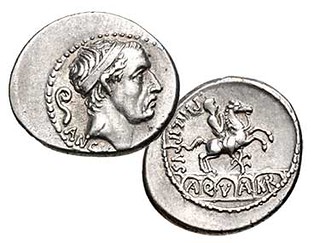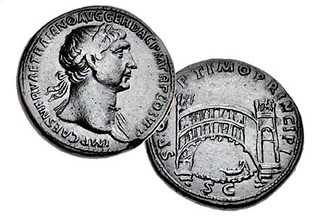
On December 29, 2016 Mike Markowitz published a nice CoinWeek article about bridges on ancient coins. -Editor
ROMANS WERE PROUD of their bridges, some of the most spectacular feats of ancient engineering. The high priest of the Roman state religion was called the Pontifex Maximus--literally the “supreme
bridge-builder”--a title later adopted by the Popes of the Roman Catholic Church.
A number of Roman coins depict bridges, but not always accurately; die engravers were not architectural draftsmen and they struggled to represent long, complex structures in the narrow circular
confines of a coin.
 For most bridges, Romans relied on the same circular stone arch used to build the aqueducts that brought water into the city. Possibly the earliest coin showing such a structure is a silver
denarius issued by a mint official named L. Marcius Philippus in 52 BCE. On the reverse, he commemorates his ancestor, Q. Marcius Rex, who constructed the aqueduct known as the Aqua Marcia in 144-140
BCE. What appears to be a man riding a horse across a bridge on the reverse is actually an equestrian statue of this builder atop the aqueduct. The coin is relatively common; different dies show
different numbers of arches. For most bridges, Romans relied on the same circular stone arch used to build the aqueducts that brought water into the city. Possibly the earliest coin showing such a structure is a silver
denarius issued by a mint official named L. Marcius Philippus in 52 BCE. On the reverse, he commemorates his ancestor, Q. Marcius Rex, who constructed the aqueduct known as the Aqua Marcia in 144-140
BCE. What appears to be a man riding a horse across a bridge on the reverse is actually an equestrian statue of this builder atop the aqueduct. The coin is relatively common; different dies show
different numbers of arches.
Trajan’s Bridge
By far the most famous Roman bridge to appear on a coin is the Danube River bridge built by Emperor Trajan in 103–105 CE for his conquest of Dacia, north of the river. Designed by the famed
Apollodorus of Damascus, it was 1,135 meters (3,724 ft.) long. Twenty massive stone and concrete piers joined by timber arches carried the roadway 19 meters (62 feet) above the surface of the
river.
 The bridge appears on three different denominations struck c. 107-110: a sestertius, a dupondius and an as. The coins only show one arch of the bridge, and the engraver
misunderstood the structure--it seems to be a two-storied covered bridge. Modern reconstructions assume the roadway was level and open–topped, supported by radially braced double wooden arches. The
massive towers topped by statuary at each end are probably correct; such towers made it easier to defend the bridge against attackers. The bridge appears on three different denominations struck c. 107-110: a sestertius, a dupondius and an as. The coins only show one arch of the bridge, and the engraver
misunderstood the structure--it seems to be a two-storied covered bridge. Modern reconstructions assume the roadway was level and open–topped, supported by radially braced double wooden arches. The
massive towers topped by statuary at each end are probably correct; such towers made it easier to defend the bridge against attackers.
Trajan’s bridge remained intact for only a few years. About 117, Hadrian ordered the timber arches dismantled to prevent Dacians from crossing to the south bank.
Some of the piers remain in place underwater (two were dynamited in 1906 to widen the navigation channel, others were swept away over the centuries). The ruins of the towers at either end are
preserved as archaeological sites by Serbia and Romania, respectively.
Marcus Aurelius’ Pontoon Bridge
When a crossing was needed quickly, Roman military engineers constructed pontoon bridges, linking anchored boats with wooden planks and framing. A sestertius of Marcus Aurelius struck ca. 171-172
shows the emperor leading legionary troops across such a bridge over the Danube. There are only three boats, and they are tiny compared to the soldiers, but the engraver managed to fit the story onto
the coin.
To read the complete article, see:
CoinWeek Ancient Coin Series: Bridges on Ancient Coins
(www.coinweek.com/ancient-coins/coinweek-ancient-coin-series-bridges-ancient-coins/)
Wayne Homren, Editor
The Numismatic Bibliomania Society is a non-profit organization
promoting numismatic literature. See our web site at coinbooks.org.
To submit items for publication in The E-Sylum, write to the Editor
at this address: whomren@gmail.com
To subscribe go to: https://my.binhost.com/lists/listinfo/esylum
Copyright © 1998 - 2024 The Numismatic Bibliomania Society (NBS)
All Rights Reserved.
NBS Home Page
Contact the NBS webmaster
| 


